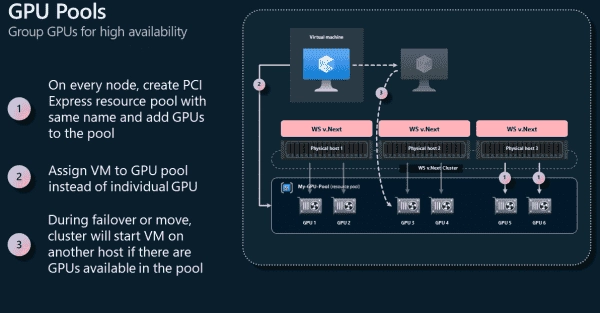As hypervisors have matured, there haven’t been too many innovations for them in recent years. The last two versions of Windows Server showed hardly any progress in this area. However, Microsoft is now addressing some overdue improvements.
Share GPU between VMs
With the increasing significance of graphics processors, particularly due to their central role for AI applications, the existing support for GPUs in Hyper-V is no longer sufficient. Up until now, it has been limited to passing a GPU through to a virtual machine using Direct Device Assignment (DDA), making it exclusively available to that particular VM.
Considering their high performance and costs, such utilization of modern graphics processors is inefficient. Therefore, Windows Server 2025 will allow the partitioning of GPUs, enabling them to be shared among multiple VMs.
Partitioning GPUs across multiple virtual machines
In addition to improving resource utilization, this GPU virtualization also supports live migration, both within a cluster and between standalone hosts. The previous concept of directly assigning physical hardware to a VM blocked the uninterrupted transfer of a VM to another host.
The same applies to the high availability of VMs, which is now supported when utilizing GPU partitions.
The new feature prerequisites are support for single-root input/output virtualization (SR-IOV), AMD Milan or Intel Sapphire Rapids processors, and Nvidia GPUs A2, A10, A16 and A40. Guests can utilize Windows 10/11, Windows Server 2019/2022, and Linux Ubuntu 18.04/20.04 LTS.
Pooling of graphics processors
Besides GPU partitioning, Windows Server 2025 can also support the converse process: that is, merging several graphics processors into a single virtual GPU. This pooling is designed solely for failover reasons, without any support for live migration because it hinges on DDA.
Administrators should create a pool of the same title on each node of the cluster and designate the Virtual Machines to this particular pool. In case a node encounters an error, the cluster will initiate the VM on a different server and link it to the related pool.
Live migration in workgroup clusters
Windows Server 2025 presents a new feature related to live migration. Starting with the 2016 version, the OS permits the creation of a cluster within a workgroup. This type of configuration is best suited for smaller scale deployments, like remote offices, where organizations are aiming to simplify the infrastructure as much as possible.
A cluster that isn’t part of an Active Directory does not traditionally offer support for all workloads and only provides quick migration for the Hyper-V role. However, Server 2025 introduces a change with its certificate-based live migration on Active Directory-less clusters.
Mixed CPUs in clusters
There is also an update to Dynamic Processor Compatibility. It allows computers with processors of different generations from the same manufacturer to be grouped into a cluster. In this case, Windows utilizes only the lowest common denominator of the CPU’s functions.
In the 2025 version, it is now possible to mix Intel Xeon processors from the third and fourth generations within a cluster.
Gen2 VMs as the default
Another change will transform second-generation VMs to the default. At present, while crafting a VM utilizing Hyper-V Manager or the Windows Admin Center, the default is indeed Gen1.
Gen2 not only delivers superior scalability but also endorses functionalities like Secure Boot, TPM, and UEFI.
Storage improvements for Hyper-V
The forthcoming release of Windows Server brings with it a range of improvements in its storage capabilities, especially aiding virtualized workloads.
Among these enhancements is the boosted performance of NVMe courtesy of a new native driver. As stated by the creator, this advancement stands to enhance the maximum amount of IOPS by as much as 90 percent in comparison to Server 2022. In addition to this, the updated operating system will feature an NVMe over Fabric Initiator for linking to SANs.
Meanwhile, ReFS is set to be equipped with a novel dedup feature which, unlike its existing version, is not just confined to cold storage. This process targets data that usually occupy file servers and rarely undergo modification. However, the updated version of ReFS dedup is also well-suited for hot data like virtual drives, thereby offering potential storage space reductions of up to 90 percent for VHD(X) and ISO files.
Summary
After a period of relatively slow innovation, Hyper-V in Windows Server 2025 receives several interesting updates. Among these is GPU virtualization, a capability VMware has had for some time and is particularly crucial for AI applications.
The OS supports both the partitioning and pooling of GPUs. The latter is intended solely for failover, whereas partitioning also allows for live migration of VMs assigned a vGPU.
